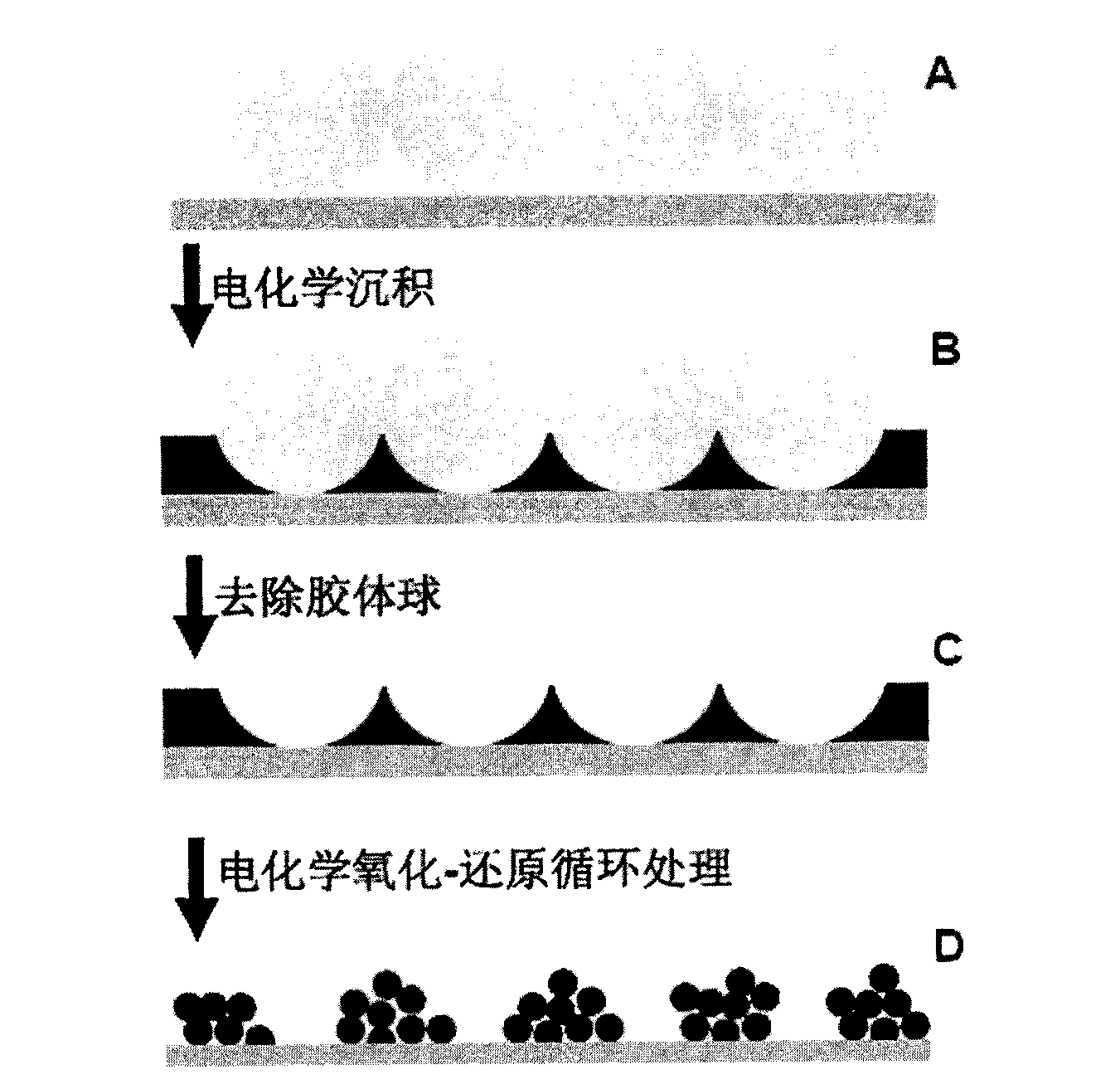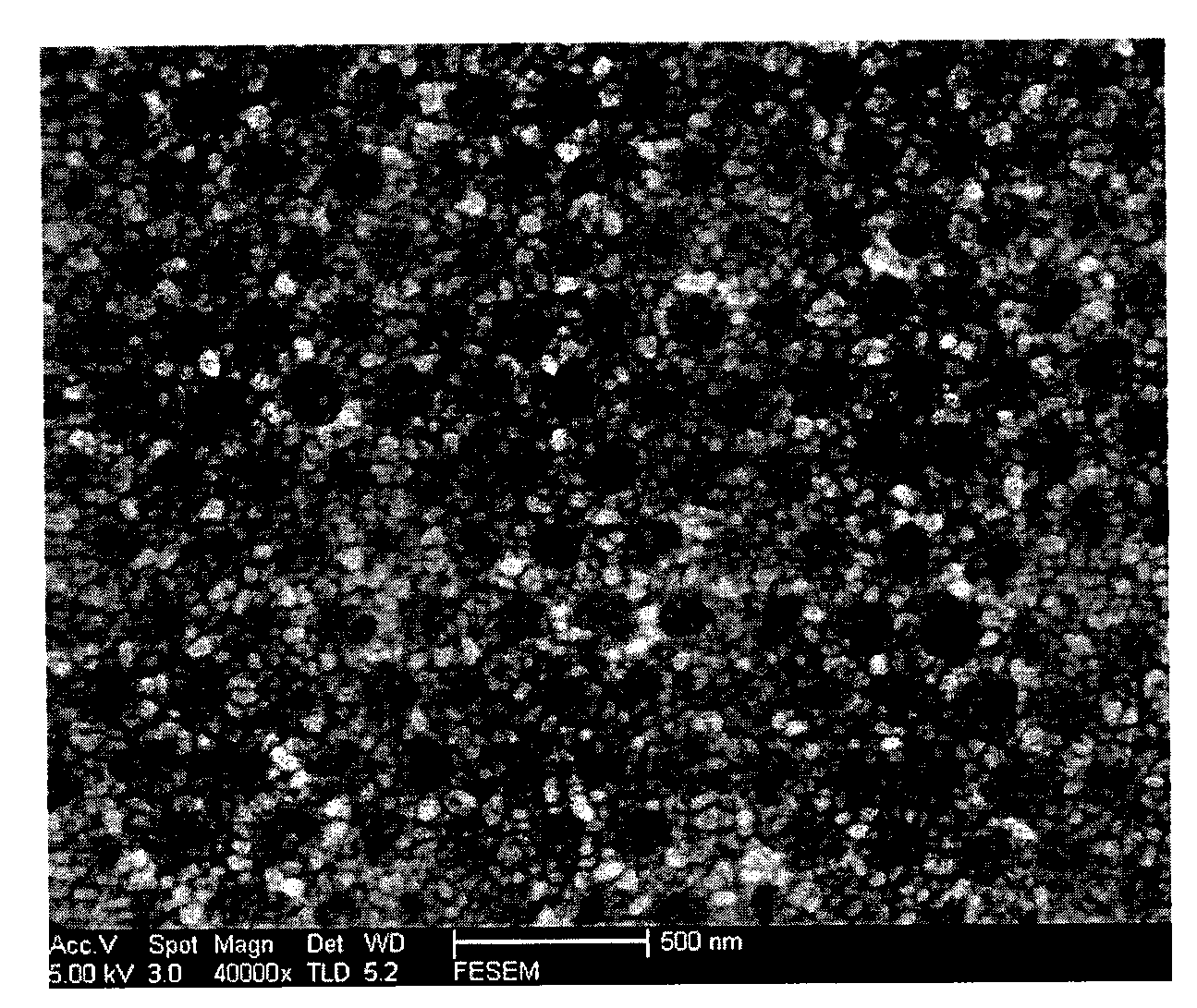Ordered hole array with gold-nanoparticle-based micro-nanometer composite structure and preparation method for ordered hole array
A gold nanoparticle and composite structure technology, applied in electrolysis process, electroforming and other directions, can solve the problems of poor stability and insufficient activity of microstructured hole arrays, and achieve high production efficiency, enhanced stability, and less materials. Effect
- Summary
- Abstract
- Description
- Claims
- Application Information
AI Technical Summary
Problems solved by technology
Method used
Image
Examples
Embodiment 1
[0026] The specific steps of preparation are:
[0027] Step 1, firstly placing a single-layer colloidal crystal template composed of polystyrene colloidal spheres with a sphere diameter of 0.3 μm on a conductive substrate; wherein the conductive substrate is conductive glass. Then, the conductive substrate on which the single-layer colloidal crystal template is placed is placed in the gold electrolyte, which is used as the working electrode, and the current density is 0.1 mA / cm. 2 The three-electrode method was used for electrodeposition for 60 min; wherein, the counter electrode during electrodeposition was a graphite electrode, and the reference electrode was a saturated calomel electrode to obtain a composite array.
[0028] In step 2, the composite array is first placed in a dichloromethane solvent to remove the polystyrene colloid spheres to obtain a gold body array. The gold body array was then placed in a potassium chloride solution with a concentration of 0.05mol / L fo...
Embodiment 2
[0030] The specific steps of preparation are:
[0031] Step 1, firstly placing a single-layer colloidal crystal template composed of polystyrene colloidal spheres with a sphere diameter of 0.3 μm on a conductive substrate; wherein the conductive substrate is conductive glass. Then, the conductive substrate with the single-layer colloidal crystal template placed on it is placed in the gold electrolyte, and it is used as the working electrode, and the current density is 0.5 mA / cm. 2 The three-electrode method was used for electrodeposition for 45 min; wherein, the counter electrode during electrodeposition was a graphite electrode, and the reference electrode was a saturated calomel electrode to obtain a composite array.
[0032] In step 2, the composite array is first placed in a dichloromethane solvent to remove the polystyrene colloid spheres to obtain a gold body array. The gold body array was then placed in a potassium chloride solution with a concentration of 0.1 mol / L fo...
Embodiment 3
[0034] The specific steps of preparation are:
[0035] In step 1, a single-layer colloidal crystal template composed of polystyrene colloidal spheres with a sphere diameter of 0.3 μm is firstly placed on a conductive substrate; wherein, the conductive substrate is conductive glass. Then, the conductive substrate with the single-layer colloidal crystal template placed on it is placed in the gold electrolyte, and it is used as the working electrode, and the current density is 1 mA / cm. 2The three-electrode method was used for electrodeposition for 30 minutes; wherein, the counter electrode during electrodeposition was a graphite electrode, and the reference electrode was a saturated calomel electrode to obtain a complex array.
[0036] In step 2, the complex array is placed in a dichloromethane solvent to remove the polystyrene colloidal balls to obtain the gold array. Then place the gold body array in a potassium chloride solution with a concentration of 0.15mol / L for electroch...
PUM
| Property | Measurement | Unit |
|---|---|---|
| particle diameter | aaaaa | aaaaa |
| diameter | aaaaa | aaaaa |
Abstract
Description
Claims
Application Information
 Login to View More
Login to View More - R&D
- Intellectual Property
- Life Sciences
- Materials
- Tech Scout
- Unparalleled Data Quality
- Higher Quality Content
- 60% Fewer Hallucinations
Browse by: Latest US Patents, China's latest patents, Technical Efficacy Thesaurus, Application Domain, Technology Topic, Popular Technical Reports.
© 2025 PatSnap. All rights reserved.Legal|Privacy policy|Modern Slavery Act Transparency Statement|Sitemap|About US| Contact US: help@patsnap.com


